Cooling system pipes
Discussion
I'm still trying to fathom out the cooling system on my 350i, I don't think it's ever been right. It fills the expansion bottle during normal running; which by implication means that the air that should be in the expansion bottle is being pumped into the engine.
Anyway I'm looking at the 2.8i Capri installation as that's where the expansion tank comes from. On the Capri the top two connections on the expansion tank go to the highest points on 1)the engine and 2)the radiator through small diameter (degas) hoses, and the connection out of the bottom of the expansion tank goes into the radiator bottom hose with a large diameter pipe. All pretty logical.
However the Capri has a funny connection on the front of the plenum, circled in the pic:
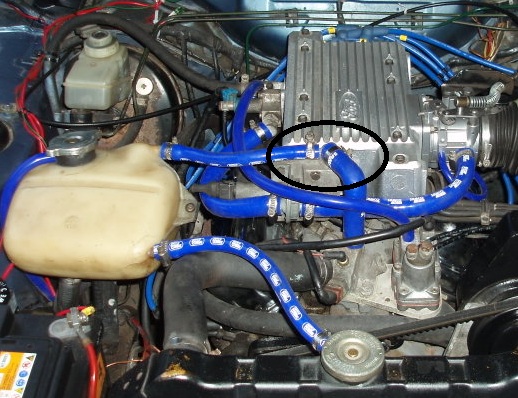
Can anyone with a 280i confirm what this plenum connection is?
Also does the 280i Tasmin have the bottom hose out of the expansion tank connected into the radiator bottom hose with large diameter pipe like the Capri?
Thanks...
Anyway I'm looking at the 2.8i Capri installation as that's where the expansion tank comes from. On the Capri the top two connections on the expansion tank go to the highest points on 1)the engine and 2)the radiator through small diameter (degas) hoses, and the connection out of the bottom of the expansion tank goes into the radiator bottom hose with a large diameter pipe. All pretty logical.
However the Capri has a funny connection on the front of the plenum, circled in the pic:

Can anyone with a 280i confirm what this plenum connection is?
Also does the 280i Tasmin have the bottom hose out of the expansion tank connected into the radiator bottom hose with large diameter pipe like the Capri?
Thanks...
Thanks for the replies guys. Interesting that the consensus is that the 280i/turbo plumbing doesn't make sense either - I guess the same guy at TVR did both the 350 and 280 designs so it's more than likely that if one is 'odd' the other will be too! So the 280i plenum connection is an 'extra air device' for cold starts so needs hot water with the thermostat closed. Makes sense; but gives a flow of water into the expansion tank at all times.
The 350i seems to be plumbed the same way as the 280 in that there's a reasonably large flow though the expansion tank with the thermostat closed (through the plenum heater); however on the 350 the bottom tank connection is connected to the radiator vent through a very small pipe... ie there's nowhere for the flow to go, so the expansion tank fills up, pushing air into the other vent connection that is connected to the top hose. On an SD1 that plenum heater flow goes back into the heater return pipe so the engine will warm up much more quickly.
Interesting what's been said about the 280 heater - the whole reason I'm getting into this is that the heater in my car is so bad that it won't demist the car; part of the issue seems to be that the flow of water with the thermostat closed appears to be mostly through the expansion tank and not through the heater matrix. At the Christmas 'do' I saw three different sets of heater plumbing on V8s, so clearly TVR were doing some 'on the fly' heater development!
Which side of the car does the heater inlet pipe go through the bulkhead on a 280?
The 350i seems to be plumbed the same way as the 280 in that there's a reasonably large flow though the expansion tank with the thermostat closed (through the plenum heater); however on the 350 the bottom tank connection is connected to the radiator vent through a very small pipe... ie there's nowhere for the flow to go, so the expansion tank fills up, pushing air into the other vent connection that is connected to the top hose. On an SD1 that plenum heater flow goes back into the heater return pipe so the engine will warm up much more quickly.
Interesting what's been said about the 280 heater - the whole reason I'm getting into this is that the heater in my car is so bad that it won't demist the car; part of the issue seems to be that the flow of water with the thermostat closed appears to be mostly through the expansion tank and not through the heater matrix. At the Christmas 'do' I saw three different sets of heater plumbing on V8s, so clearly TVR were doing some 'on the fly' heater development!
Which side of the car does the heater inlet pipe go through the bulkhead on a 280?
Interesting... so the 280i heater is plumbed the opposite way to the 350. The '86 350/390 flow is into the heater matrix on the left hand side (opposite the driver on a RHD car) - I think that's wrong, sounds like the 280 is correct. The 400 and later 350's are different.
One car I looked at (an '89 350) had the '4 way' bypassed heater valve; my '86 doesn't; 'development' on the fly...
I have also studied the SD1 cooling system; that has the plenum heater plumbed back into the heater return and not connected to the expansion tank; I intend to replicate that. The SD1 is different though; the 'de-airation' function is in the top of the radiator and the 'expansion' tank is purely an overflow tank in the way that later wedges had a second tank connected into the cap of the 'Capri' tank. 'Development' again!
One car I looked at (an '89 350) had the '4 way' bypassed heater valve; my '86 doesn't; 'development' on the fly...
I have also studied the SD1 cooling system; that has the plenum heater plumbed back into the heater return and not connected to the expansion tank; I intend to replicate that. The SD1 is different though; the 'de-airation' function is in the top of the radiator and the 'expansion' tank is purely an overflow tank in the way that later wedges had a second tank connected into the cap of the 'Capri' tank. 'Development' again!
The SD1 rad is higher than that in the wedge which is probably the reason for TVR using the Capri tank, amd positioning it as high as they could in the engine bay. I don't think they put enough thought into what the effects of the plumbing were; or (more likely) they chose the easy/cheap option that seemed to work. The evidence is that they kept meddling with the cooling system so I suspect it wasn't quite right on early cars.
My heater matrix is vertical with a high inlet connection on the passenger side (RHD):
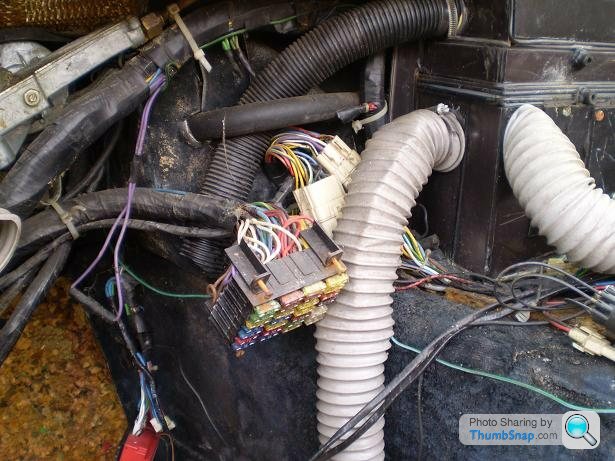
And a low outlet connection on the driver's side (hard to see in the pic but it's there!)
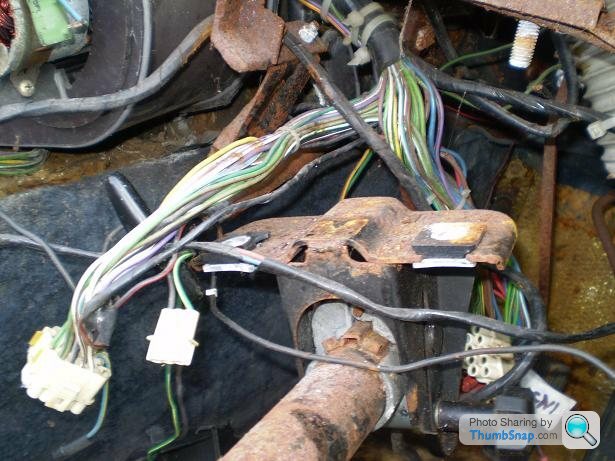
The pics are my '86 SEAC but the 350i (also '86) looks very similar as far as I can tell.
I've bought all the bits I need to replumb, so as soon as the inlet manifold is back from welding (long story!) I'll be putting my ideas into practice.
My heater matrix is vertical with a high inlet connection on the passenger side (RHD):

And a low outlet connection on the driver's side (hard to see in the pic but it's there!)

The pics are my '86 SEAC but the 350i (also '86) looks very similar as far as I can tell.
I've bought all the bits I need to replumb, so as soon as the inlet manifold is back from welding (long story!) I'll be putting my ideas into practice.
Update time... I've now plumbed both my 350i and the SEAC to what I think they should be; both cars have been running all summer without overheating or spitting coolant out; and I have effective heat and demisting on demand.
Basically I've done three things, centred around the expansion tank:
1) Changed the 'de-gas' system - ie the engine and radiator vent lines
2) Rerouted the plenum heater outlet pipe
3) Put a 'tee-piece' in the radiator bottom hose.
The de-gas system; note the blocked off middle connection on the expansion tank. The highest point on the radiator and the highest point on the engine (the swan neck) are now connected to the highest point on the expansion tank:
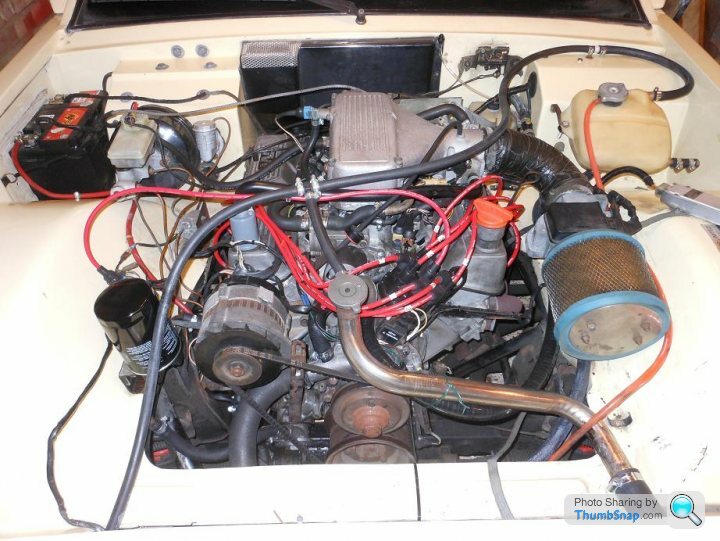
The plenum heater outlet is connected to the heater return pipe on the water pump inlet, as it is on the SD1 - and NOT the expansion tank middle connection.
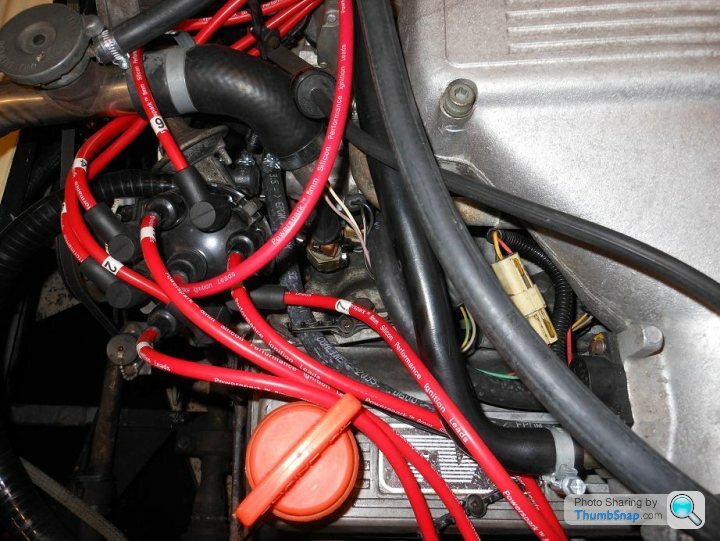
And the bottom pipe on the expansion tank (the 5/8 diameter one) is connected to a tee-piece in the radiator bottom hose, replacing the original bottom hose 'straight' section.
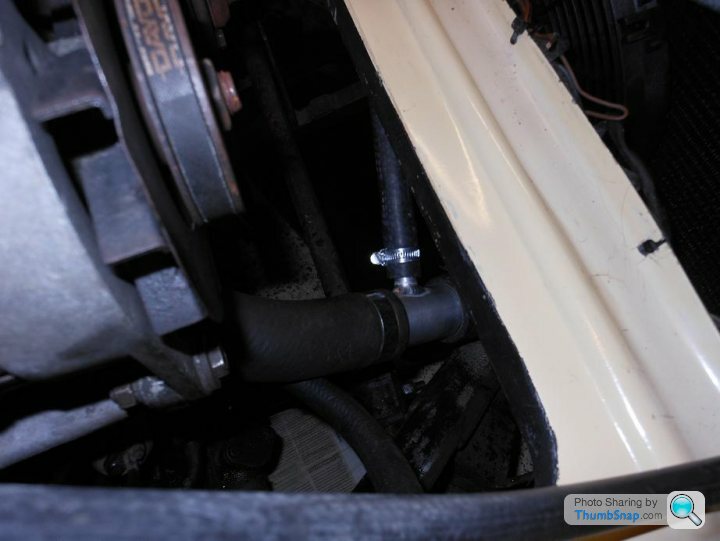
With TVR's set up, the plenum heater outlet pumped coolant into the expansion tank, resulting in air being forced into the swan neck and then through the rad into the engine- so the expansion tank was always full and the engine (and heater) always had air in it... not clever! With the set up I now have, the engine and heater are always full of coolant and there's always air in the top of the expansion tank, where it should be.
I have also found that it's much better to switch the fan in manually when the car comes to a standstill rather than wait for the radiator mounted otter switch to activate the fan. I believe the rad mounted otter switch is too far away from the engine and is too slow to react; when Rover/MG fitted electric fans they put the sensor (otter switch equivalent) onto the thermostat cover, ie right on top of the engine.
I've done what I think is right, feel free to shoot me down with 'TVR knew what they were doing' flames but I know that my cars now run much better than they did before so I'm happy! I looked at lots of cars at the fest and there were many variations on the plumbing theme; one thing I did find interesting though was that early cars (Mr Tank's) were plumbed in a similar way that I have now done mine - I'm not sure why TVR moved away from that. My suspicion is that the electric fan set up on the 350s didn't work very well; my solution of mimicing a viscous fan by manually switching in the fan when the car is at a standstill probably wouldn't have been acceptable to buyers of new TVRs back in the day...
Basically I've done three things, centred around the expansion tank:
1) Changed the 'de-gas' system - ie the engine and radiator vent lines
2) Rerouted the plenum heater outlet pipe
3) Put a 'tee-piece' in the radiator bottom hose.
The de-gas system; note the blocked off middle connection on the expansion tank. The highest point on the radiator and the highest point on the engine (the swan neck) are now connected to the highest point on the expansion tank:

The plenum heater outlet is connected to the heater return pipe on the water pump inlet, as it is on the SD1 - and NOT the expansion tank middle connection.

And the bottom pipe on the expansion tank (the 5/8 diameter one) is connected to a tee-piece in the radiator bottom hose, replacing the original bottom hose 'straight' section.

With TVR's set up, the plenum heater outlet pumped coolant into the expansion tank, resulting in air being forced into the swan neck and then through the rad into the engine- so the expansion tank was always full and the engine (and heater) always had air in it... not clever! With the set up I now have, the engine and heater are always full of coolant and there's always air in the top of the expansion tank, where it should be.
I have also found that it's much better to switch the fan in manually when the car comes to a standstill rather than wait for the radiator mounted otter switch to activate the fan. I believe the rad mounted otter switch is too far away from the engine and is too slow to react; when Rover/MG fitted electric fans they put the sensor (otter switch equivalent) onto the thermostat cover, ie right on top of the engine.
I've done what I think is right, feel free to shoot me down with 'TVR knew what they were doing' flames but I know that my cars now run much better than they did before so I'm happy! I looked at lots of cars at the fest and there were many variations on the plumbing theme; one thing I did find interesting though was that early cars (Mr Tank's) were plumbed in a similar way that I have now done mine - I'm not sure why TVR moved away from that. My suspicion is that the electric fan set up on the 350s didn't work very well; my solution of mimicing a viscous fan by manually switching in the fan when the car is at a standstill probably wouldn't have been acceptable to buyers of new TVRs back in the day...
Gassing Station | Wedges | Top of Page | What's New | My Stuff



